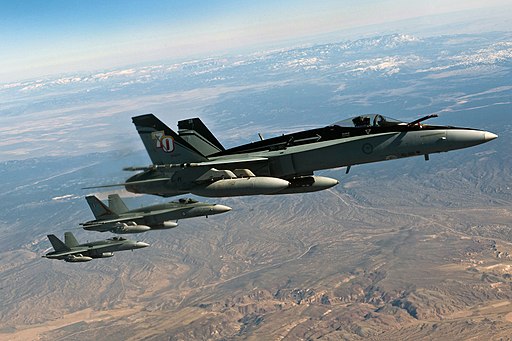Australia, the United States, and Ukraine are engaged in discussions regarding the potential deployment of 41 Royal Australian Air Force F/A-18 Hornets to Kyiv, according to a new report by Australia Financial Review. This initiative aims to fulfill Ukraine President Volodymyr Zelensky’s request for fighter jets, diverting them from their planned fate of being scrapped.
U.S. Air Force photo by Senior Airman Brett Clashman / Public domain
Sources suggest that the US, which recently granted permission to other Western allies to supply Ukraine with advanced fighter jets, including US-made F-16s, is favorably inclined to gifting the F/A-18s to Ukraine. Washington’s approval is crucial as it retains intellectual property rights over the retired jets, which Australia is replacing with F-35s.
At present, the retired F/A-18s are stored at the Williamtown RAAF base near Newcastle. If not sent to Ukraine, they face the options of either being scrapped or sold to RAVN Aerospace, a private sector aviation company in the US, for training purposes.
Back in March 2020, then Minister for Defence Industry for Australia, Melissa Price, announced a decision to sell up to 46 of those Hornets to AirUSA, the former name for RAVN Aerospace.
Negotiations are ongoing, but a finalized deal has not yet been reached, according to Robert Potter, an Australian security expert advising the Ukrainian government. Defence Minister Richard Marles declined to comment on the matter but referred to Australia’s commitment to supporting Ukraine and contributing to the war effort.
The Royal Australian Air Force (RAAF) procured 75 F/A-18s in 1981 as a replacement for the aging Mirage III fighters, which had served since 1963. The initial two aircraft were manufactured in the US, while the remaining were assembled in Australia at Government Aircraft Factories. These Hornets were introduced into RAAF service from 1984 to 1990. Unfortunately, four Hornets were lost due to flying accidents in the late 1980s and early 1990s.
These fighters underwent the Hornet Upgrade Program (HUG) in 1999 and were carried out in three main phases. In Phase 1, which took place from mid-2000 to 2002, the fighters underwent significant improvements. This included the replacement of their computer systems, navigation system, and radio. Additionally, the aircraft were equipped to operate the ASRAAM air-to-air missile, which replaced the AIM-9 Sidewinder.
Phase 2 of HUG consisted of several sub-elements aimed at enhancing the Hornets’ combat performance. In Phase 2.1, the APG-65 radar was upgraded to the improved AN/APG-73, and secure voice encryption communications systems were installed. Various updates were also made to the computer systems. Phase 2.2, considered the most crucial element of the program, involved the installation of the Joint Helmet Mounted Cueing System, the integration of the Link 16 network for data sharing, the implementation of a new countermeasures dispensing system, and several cockpit display upgrades. All Hornets were upgraded to this standard between January 2005 and December 2006. Phase 2.3 focused on improving the Electronic Counter Measures system, with the initial selection of the AN/ALR-2002 being replaced by the ALR-67 Radar Warning Receiver in late 2006. By early 2012, 14 Hornets had been fitted with the system, and the remaining aircraft were scheduled to receive it by the end of that year. The final phase, 2.4, involved modifying the Hornets to be compatible with the AN/AAQ-28(v) “LITENING” targeting pod, with 37 of these systems being purchased. This phase was successfully completed in 2007. The last phase was to rectify airframe fatigue damage to the aircraft during its service life.
For more information, hit the Source below

What problem does State Department have against RAVAN? They have been stringing the sale for almost two years.